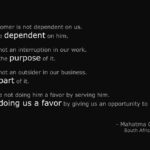So screams the headline of an article in Harvard Business Review that analysed the findings of a research study by The Customer Contact Council. It covered more than 75,000 customers on their service interactions across a wide range of industry sectors, where loyalty was defined as the customers’ intention to continue doing business with a company, increase their spending, or say good things about it/refrain from saying bad things. https://hbr.org
This goes completely against the grain of the good gospel of customer service where choir songs are sang about ‘providing delightful customer experiences’, ‘ going above and beyond the call of duty’ and ‘amazing and astounding customers’. To be blatantly instructed to stop all this is to try and re-write the ten commandments of customer service and to re-wire the hard-wiring of customer service enthusiasts.
However………..
I’ve further examined this ‘alter’ call, and the underlying lesson being pushed is that customers thrive on order, structure, predictability and stability. Now this is familiar territory. Indeed customers thrive on predictability and being able to pre determine what their experiences are going to be. In the hospitality industry for example, one’s favourite restaurant is so because it makes their favourite steak in a certain way always.
And the predictability of arriving and requesting the steak and having it placed on the table in the exact same way it always is, is what creates customer loyalty. And this loyalty will increase twentyfold if the favourite steak arrives and the server announces to the customer that it has been done up ‘just the way you like it’. When this customer makes a recommendation or referral to a friend – they know exactly what they are recommending. No surprises.
In the tangible goods and products industry, the consistent look and feel of one’s favourite bathing soap is what keeps them loyal to it year after year. The external packaging may change, but the size of it in their hands, the lathering effect, the smell of it, the feel of it on their skin, the absence of adverse reactions and the efficacy in cleaning is what pulls the shopper to the shop specific shelf year after year. When this customer recommends the bathing soap to friends and family – they know exactly what they are recommending. No surprises.
So…………
Efforts to ‘delight’ customers should be undertaken yes… but over and above delivering exactly what the customer expects. The restaurant for example, over and above providing the expected standard of steak, could provide personalized service that would delight the customer. The soap manufacturer could also, over and above maintaining the consistency of the bathing soap, band together another complimentary item as a free giveaway. These extras are welcome and the delight will be first and foremost from delivering on expectation and secondly from the additional throw-ins.
Customer service efforts therefore should invest largely in establishing systems, processes, procedures and guidelines to consistently deliver on the brand promise. Investment should also be placed on preventing and recovering from service failure, and turning around customer conflict situations to right wrongs and put in place preventive actions. Once and only once this is perfected and streamlined, should commencement work on ‘customer delight’ strategies be instituted.
After all – the intriguing research revealed that loyalty has a lot more to do with how well companies deliver on their basic, even plain-vanilla promises than on how dazzling the service experience might be. We all therefore need to get our priorities right….. right?









